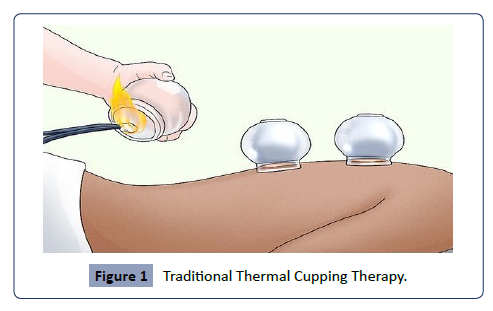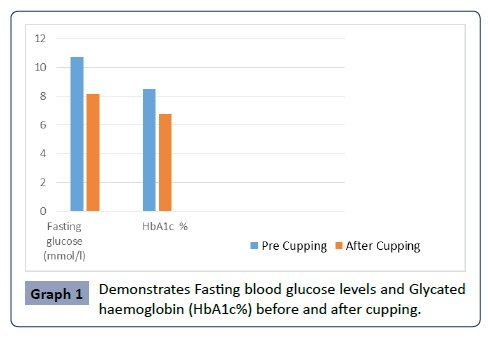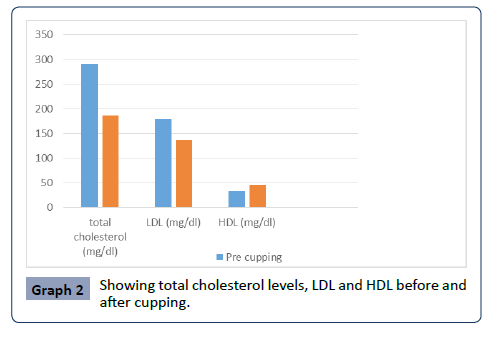Abstract
Introduction: Type 2 Diabetes Mellitus (T2DM) is a group of metabolic disorders characterized by insulin resistance. It’s a multifactorial chronic disease and if not managed properly, it can lead to complications in both short-term and long-term incidences. These complications involve intensified blood cholesterol due to high incidence of blood glucose, which can lead to several complications. The gold standard treatment for T2DM is metformin, however other approaches have been studied in conjunction with the standard treatment, which can lead to improvement of cholesterol and blood sugar levels in diabetic patients in order to prevent further complications
Method: Thermal Dry Cupping Therapy was done using traditional glass cups on 30 T2DM patients, who have been diagnosed with diabetes for more than three years and are still using metformin. This method was repeated once a week for 4 weeks. Then fasting blood samples were obtained to measure the levels of blood glucose and lipid profile for total cholesterol levels, low density lipoprotein (LDL) and high density lipoprotein (HDL). Whereas the % of HAb1c was determined by ELISA method.
Result: Post cupping measurements showed a significant decrease in fasting blood glucose measurements of 8.15 ± 1.09, % HAb1c of 45.71±5.89, and a significant decrease in total cholesterol levels of 186.65±27.83 and low density lipoprotein (LDL) of 135.73±15.2, however an increase in high density lipoprotein (HDL) of 45.71±5.89 was observed
Conclusion: The data suggest that several sessions of Thermal Dry Cupping therapy can decrease values of total cholesterol, low density lipoprotein, fasting blood glucose and percent of glycated haemoglobin. Hence, it might play a role in the improvement of impaired glucose metabolism, which can be beneficial as a complementary treatment for T2DM in Omani patients besides the standard treatment.
Keywords
Thermal Dry Cupping Therapy; Type 2 Diabetes Mellitus; Fasting blood glucose;
Lipid profile; Glycated Haemoglobin and Glucose metabolism.
Introduction
Type 2 Diabetes Mellitus (T2DM) is known as adult-onset diabetes
and comprises approximately 90% of people with diabetes.
T2DM usually includes a component of insulin resistance and
over time results in β-cell failure. It is hard to target a single risk
factor for T2DM as it is a combination of genetics, environment,
and poor lifestyle, which lead to insulin resistance, obesity,
and other diabetes related complications. These complications
include; macrovascular disease, neuropathy, nephropathy and
retinopathy. T2DM can be managed by alterations in lifestyle and
diet, but over time the majority of people progress to needing
oral and injectable diabetes therapies.
Since early times, complementary and alternative medicine has
played an important role in human health and welfare. Many
therapeutic approaches in healthcare outside the margins of
conventional medicine persist in various parts of the world [1].
Thermal dry cupping therapy (TDCT) is a traditional healing
technique that has been employed in various cultures for
centuries. It involves the use of heated cups placed on the skin
to create a vacuum, which in turn, draws the skin and underlying
tissues into the cup. The therapy is believed to offer a wide range
of benefits, both physical and psychological. This literature review
explores the benefits of heat cupping therapy, citing relevant
research to support each claim. One of the most commonly
reported benefits of heat cupping therapy is pain relief. Research
by [2], found that heat cupping therapy was effective in reducing
musculoskeletal pain, including lower back pain and neck pain.
The application of heat helps to relax muscles and increase blood
flow, which can alleviate discomfort and promote healing [3].
TDCT has been shown to enhance blood circulation. A study
conducted by [4], demonstrated that cupping therapy increased
microcirculation in the treated areas. Improved blood flow can
aid in the delivery of oxygen and nutrients to tissues, which is
essential for healing and recovery.
Cupping therapy, including heat cupping, is known to have a
relaxing effect on the body. It can help reduce stress and anxiety
levels [5]. Reported that cupping therapy induced a calming
effect and reduced the participants' perception of stress. Some
supporters of heat cupping therapy suggest that it helps the
body detoxify by drawing out toxins through the skin. While
more research is needed in this area, a study by Kim et al. (2019)
did find that cupping therapy resulted in increased excretion of
certain waste products through urine. Therefore, we hypothesis
that TDCT in conjunction with T2DM treatment can improve
fasting blood glucose levels, % of Glycated Haemoglobin, and
lipid profile in T2DM patients
Subjects
Subjects: 30 subjects were enrolled in the study. Twenty Omani
Type 2 diabetic patients on (all were male subjects, mean age
56.11 ± 1.48 years). Informed consent was obtained for all study
participants. All diabetic patients were previously diagnosed
cases and are on metformin drug; the mean duration of T2DM for
more than 3 years. It was recommended that patient should not
eat at least 2-4 hours before cupping.
Methods
Methods of cupping
Traditional glass of cups made was used on 30 diabetic Omani
patients and was repeated twice a week for a period of 4 months.
The Glass cups used in this study are heated with an open flame
(Figure 1). Soaked cotton ball or a candle was used as a heat
source in the study.
Figure 1:Traditional Thermal Cupping Therapy.
Massage oil or lotion was used to lubricate the skin and create a
seal for the cups to adhere to. A Cotton balls or a small towel was
used for extinguishing the flame and creating a vacuum inside the
glass cups (Figure 1).
Random fasting blood glucose
Measurements were taken daily by obtaining a blood sample
from the fasting patients over night or for at least 8 hours then
using the glucometer to determine the values of blood sugar,
each measurement was repeated thrice for accuracy.
HbA1c: The levels of HbA1c were determined by ELISA method.
Samples were centrifuged for 15 minutes. Sample was removed
and assay was performed immediately by using a human HBA1c
kit. 50 μL of each standard, control and sample were added into
a 96 well pre coated microplate. Then 50 μl of Detection Reagent
A was added to each well, sealed then incubated for 1 hr at 37 °C.
Plate was washed 3X with 1X wash buffer. Then 100 μL of Detection
Reagent B was added into each well, sealed and incubated at 37°C
for 30 min. washing was repeated as previously but for 5X. 90 μl
of TMB Substrate was added to each well, sealed then incubated
at 37°C for 10-20 min, avoiding exposure to light. 50 μL of stop
solution was added to each well then the plate was read at 450
nm immediately. There is an inverse correlation between HbA1c
concentration in the sample and the absorbance measured, the
HbA1c concentration of the samples was interpolated from the
standard curve.
Lipid Profile: Patients were asked to fast overnight or for at least
eight hours, a blood sample was drawn for a fasting lipid profile.
The test provides a measurement of the serum concentrations
of total cholesterol, triglyceride, HDL-C, and calculated LDL-C.Standard lipid analysis includes measurements of serum
or plasma total cholesterol, triglycerides, and high density
lipoprotein cholesterol (HDL-C) after an overnight fast. Low
density lipoprotein cholesterol (LDL-C) is then calculated using
Friedewald formula.
Data Handling and Statistical Methods
The statistical software package (SPSS version 20.0) was used
for data management and analysis. The data were subjected to
the Kolmogorov- Smirmov test to determine the distribution and
method of analysis. As most of the data was normally distributed
continuous variables student’s t test was used. The data were
analyzed by one-way ANOVA and Pearson correlation coefficient.
All the results are expressed as mean ± standard error of the
mean (SEM), and with the level of significance set at P<0.05.
Results
Characteristics of subjects investigated are present in Table
(1). The mean and ± SD values of the age for the diabetic male
subjects mean age 56.11 ± 1.48 years.
| Characteristics of Subjects |
Subjects with diabetes |
Gender
Male |
30 |
Age
(years) |
56.11 ± 1.48 |
Table 1: Characteristics of the studied subjects.
Table (2) demonstrates mean and ± SD values of fasting blood
glucose (FBG) and HbA1c, total cholesterol, low density lipoprotein
(LDL) and high density lipoprotein (HDL), of investigated subjects.
Fasting blood glucose (FBG) levels were (10.75 ± 1.31 mmol/L)
in the pre cupping diabetic patients compared post cupping
treatments the levels were (8.15 ± 1.09 mmol/L). The data
showed that there is a significant decrease in fasting blood
glucose (p <0.05)
| Parameters |
Subjects with diabetes pre-cupping therapy (Mean ±SD) |
Subjects with diabetes post cupping therapy (Mean ±SD) |
| Fasting glucose (mmol/L) |
10.75 ± 1.31 |
8.15 ± 1.09 |
| HbA1c (%) |
8.5 ± 0.46 |
6.8 ± 0.35 |
| Total Cholesterol (mg/dL) |
290.99 ± 19.88 |
186.65 ± 27.83 |
| LDL (mg/dL) |
179.26 ± 23.2 |
135.73 ± 15.2 |
| HDL (mg/dL) |
34.41 ± 3.8 |
45.71 ± 5.89 |
Table 2: Blood parameters of studied subjects pre and post cupping.
Graph (1) demonstrates fasting blood glucose levels and Glycated
haemoglobin (HbA1c) % pre and post cupping. HbA1c levels were (8.5 ± 0.46%) in the pre-cupping diabetic patients compared to
the HbA1c levels of post-cupping (6.8 ± 0.35%). The data showed
that there is a significant decrease in HbA1c % of the subjects (p
<0.05).
Graph (2) shows total cholesterol, LDL and HDL pre and
post cupping. The pre cupping total cholesterol levels were
290.99±19.88mg/dl. Post cupping the total cholesterol levels
decreased to 186.65±27.83 mg/dl. The data showed that there is
a significant decrease in total cholesterol levels (p <0.05)
Results of pre cupping low density lipoprotein (LDL) were
179.26±23.2 mg/dL and post cupping values were 135.73±15.2
mg/dL. The data showed that there is a significant decrease in
LDL of the subjects (p <0.05).
Results of pre cupping high density lipoprotein (HDL) were
34.41±3.8 mg/dL and post cupping values were 45.71±5.89mg/
dL The data showed that there is significant increase in HDL of the
subjects (p <0.05) (Tables 1-2) (Graphs 1-2).
Graph 1:Demonstrates Fasting blood glucose levels and Glycated
haemoglobin (HbA1c%) before and after cupping.
Graph 2:Showing total cholesterol levels, LDL and HDL before and
after cupping.
Discussion
The review of literature has shown the increased interest in
ascertaining the relationship between diabetes mellitus and cupping heat therapy in different medical conditions,. Constantly
increasing research tries to discover the exact role of cupping
heat therapy in improvement of glucose metabolism.
In our study our results showed a decrease in the levels of fasting
blood glucose (FBG) (10.75 ± 1.31 mmol/L) in the subjects pre
cupping compared to post cupping treatments the levels were
(8.15 ± 1.09 mmol/L). The data showed that there is significant
decrease in fasting blood glucose (p <0.05). Also, HbA1c levels
were (8.5 ± 0.46%) in the subjects pre-cupping compared to the
HbA1c levels post-cupping (6.8 ± 0.35%). The data showed that
there is significant decrease in HbA1c % of the subjects (p <0.05).
These results indicated that there was a positive correlation
between cupping heat therapy and glucose metabolism disorder.
These results were in agreement with a study by [6], investigated
the immediate effects of heat cupping on blood glucose levels in
a small group of individuals with type 2 diabetes. The researchers
found a statistically significant decrease in blood glucose levels
immediately after a single session of heat cupping therapy. This
reduction in glucose levels was attributed to improved circulation
and enhanced insulin sensitivity.
[7], claimed that the effect of cupping might be due to stimulating
blood circulation and supplying nutrients to beta cells in the
pancreas. In addition to controlling insulin production levels.
Lipid profile values were detected in blood samples of the subjects
which included total cholesterol, LDL and HDL pre cupping and
post cupping therapy. The total cholesterol levels pre cupping
was 290.99±19.88mg/dl. Post cupping the total cholesterol levels
decreased to 186.65±27.83 mg/dl. The data showed that there is
significant decrease in fasting glucose (p <0.05)
Results of low density lipoprotein (LDL) 179.26±23.2 mg/dl pre
cupping and 135.73±15.2 mg/dl post cupping. The data showed
that there is significant decrease in LDL of the subjects (p <0.05).
Results of High-density lipoprotein (HDL) 34.41±3.8 mg/dl pre
cupping and 45.71±5.89mg/dl post cupping. The data showed
that there is significant increase in HDL of the subjects (p <0.05).
Impaired glucose metabolism can cause changes in the lipid
profile, β cell dysfunction and insulin resistance can be induced
by elevated levels of triglycerides, which lead to elevated levels of
free fatty acids [8]. The exact mechanism is partially understood,where disruption of the cascade linking insulin receptors with
glucose transporter can be caused by elevated free fatty acids [9].
Dyslipidemia which is characterized by elevated triglycerides, low
HDL-C and the predominance of small-dense LDL particles is seen
in 60-70% of type 2 diabetes patients. An increased catabolism
of HDL and a shift to LDL can be as a result of increased levels
of triglycerides in the blood leading to hypertriglyceridemia.
Additionally, inflammation can be modulated by free fatty acids,
so hypertriglyceridemia can cause inflammation which leads to
insulin resistance and β cell dysfunction, therefore improvements
in blood glucose levels can improve lipid profile levels [10- 12]. A Study have shown that HDL may directly affect glucose
metabolism, as less hyperglycaemia was associated with higher
concentrations of HDL. This is achieved by the anti-inflammatory
properties of HDL and alteration of lipid environment by induction
of reverse cholesterol transport. Additionally, many studies
have shown that the goal is to decrease LDL levels to <100 mg/
dL in diabetic patients, if statins therapy can’t achieve this then
combination therapy is recommended [13, 14].
These findings of this study agreed with results of [15-24], which
recommended cupping as a prophylactic and/or complementary
treatment for hyperglycaemia and hyperlipidaemia and confirmed
the short-term health benefits of cupping therapy.
Conclusions
In conclusion, while there is some preliminary evidence to
suggest that heat cupping therapy may have a positive impact on
fasting blood glucose levels and subsequent effects of diabetes
mellitus on the lipid profile. Further research is needed to confirm
these findings and understand the underlying mechanisms. Heat
cupping therapy should not replace standard pharmacological
diabetes mellitus treatment but maybe prophylactic and/or
complementary to diabetes treatment.








